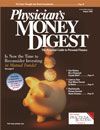Publication
Article
Physician's Money Digest
Close-Up: New York Stock Exchange
Author(s):
n.
New York Stock Exchange (NYSE): The oldest and largest stock exchange in the United States, the NYSE is responsible for setting policy, supervising member activities, listing securities, overseeing the transfer ofmember seats, and evaluating applicants.
The New York Stock Exchange (NYSE) tracesits roots back to 1792, when 24 New YorkCity stockbrokers and merchants signed theButtonwood Agreement, named for a buttonwoodtree that had served as their informal meetingplace on Wall Street. By 1817, the New York brokersestablished a formal organization, the New York Stock& Exchange Board (NYS&EB) and rented rooms at 40Wall Street. While there, they adopted a constitutionwith rules for the conduct of business.
Since then, the organization's multipronged missionhas been unwavering. Its focus is to add value to thecapital raising and asset management process by providingthe highest quality and most cost-effective self-regulatedmarketplace for the trading of financial instruments,promote confidence in and understanding of thatprocess, and serve as a forum for discussion of relevantnational and international policy issues.
Early Years of the Exchange
The day the NYSE opened its doors, approximately20,000 turned out to tour the grand facility.They were eager to see the austere architecture thatsymbolized the strength and security of the NYSE.Annual trading at the NYS&EB had reached a peakof 380,000 shares by 1824, which declined drasticallyby 1829. In 1830 the first railroad stock, Mohawk& Hudson, was traded on the NYS&EB. Railroadsecurities dominated trading for the rest of the 1800s.By 1835, average daily volume reached 8500 shares,a 50-fold increase in just 7 years.
As the 20th century approached, the NYSE was inthe midst of a sustained rise in trading volume.Trading in listed stocks had tripled between 1896 and1899, and would nearly double again by 1901. Withthis growth came the need for additional space, andon Apr. 22, 1903, the new NYSE building at 18Broad Street opened.
Considered an example of masterful architecture,the trading floor measures 109 x 140 feet, with marblewalls rising 72 feet and a skylight measuring 30-squarefeet. The entire front of the building is glass, making foran incredible window 96 feet long and 50 feet high. Thebuilding is also one of the first structures in the worldthat employed air conditioning.
Continuous Evolution
As trading volumes grew, the NYSE continued toexpand. In 1922, the 11 Wall Street facility opened,including a 23-story office building and an addition tothe trading floor named the Garage. In 1969 a thirdtrading room, the Blue Room, was opened to meet thedemands of increased volume. It expanded the size ofoverall trading space by 20%. The Blue Room wasenlarged in 1988, creating the Extended Blue Room. In2000, a fifth trading room located at 30 Broad Streetopened, featuring redesigned straight-line trading postsand the latest market information display technology.
Today the NYSE employs approximately 1500 menand women working in various departments and divisions.Its success rests on a foundation of sophisticatedtechnology, the result of investing more than $2.5 billionover the last 12 years.
Every one of the NYSE's investor orders are deliveredelectronically to the central point of sale. Slightlymore than 10% of total NYSE volume is executed automaticallyvia NYSE Direct+—more than the volume ofall electronic communications networks combined.NYSE Direct+ offers immediate, anonymous, and automatedexecution for those customers who want it, guaranteeingthe best-displayed price in the NYSE system.
A lot has changed in the past 200 years, but the commitmentto member and investor needs remains the cornerstoneof what has become both a New York City anda national landmark.
NYSE Firsts and Records
In its over 200-year history, the NYSE has experiencedmany historic firsts, reached major milestones,and set new records. The following are just a sampleof those highlights:
- First listed company—Bank of New York, tradedunder the Buttonwood Agreement, 1792
- Lowest price paid for a membership in theNYSE—$2750 in 1871
- Highest price paid for a membership in theNYSE—$2,650,000 on August 23, 1999
- Daily share volume—1 million in 1886; 2 billionin 2001
- Highest volume day—2,812,918,977 shares weretraded on July 24, 2002
- Lowest volume day—31 shares were traded onMar. 16, 1830
- Biggest single-day jump for the Dow—499.19points on Mar. 16, 2000
- Biggest single-day drop for the Dow—617.78points on Apr. 14, 2000
- Highest closing for the Dow—11,722.98 on Jan.14, 2000
Pop Quiz
1) The NYSE roots date back to
- 1782
- 1792
- 1817
- 1830
2) The NYSE expanded to a new building at 18 BroadStreet in
- 1901
- 1903
- 1910
- 1915
3) The front of the building at 18 Broad Street is constructedentirely of
- Glass
- Granite
- Formica
- Tupperware
4) What percentage of investor orders are deliveredelectronically to the NYSE's central point of sale?
- 50%
- 75%
- 90%
- 100%
5) The lowest price paid for a NYSE membership was
- $2500
- $2750
- $3000
- $1.99
Answers: 1) b; 2) b; 3) a; 4) d; 5) b.
